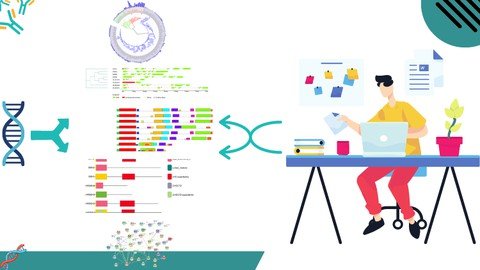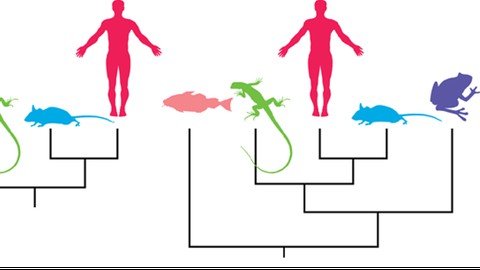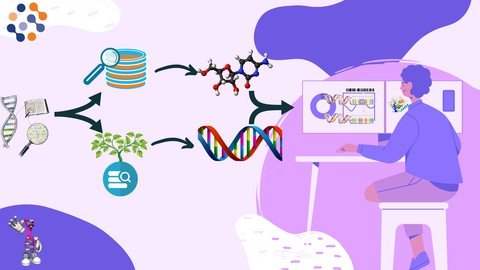Bioinformatics Research Guide-Using Analysis To Write Paper
"softddl.org"
27-08-2022, 01:14
-
Share on social networks:
-
Download for free: Bioinformatic
-

Published 8/2022
MP4 | Video: h264, 1280x720 | Audio: AAC, 44.1 KHz
Language: English | Size: 2.46 GB | Duration: 6h 9m

Published 8/2022
MP4 | Video: h264, 1280x720 | Audio: AAC, 44.1 KHz
Language: English | Size: 2.46 GB | Duration: 6h 9m
How to do Bioinformatics Research Genome wide identification in Plants Using bioinformatics analysis to write research
What you'll learn
• Choosing a gene family
• Choosing a plant for gene family research
• Searching for previously published paper
• selecting the office to work with on different platforms
• Selecting the references software
• How to use Mendeley - Reference Management Software
• Sequence Retrieval Analysis
• Homology Searching
• Sequence Alignment
• Sequence identity and Similarity analysis
o What is phylogenetics and Tree construction
• Gene Structures introns and exons map
• Motifs identification Analysis
• Domains Visualization Analysis
• Chromosomal Mapping (Distribution of Genes on chromosome)
• physiochemical characteristics analysis
• Cis-acting regulatory elements prediction analysis
• Protein Interaction network analysis
• Gene Enrichment Analysis
• Gene expression Profiles analysis
• Sra Database Introduction
• NGS sequence Analysis
• Use of trimmomatic tool
• Quality Control of sample
• Genome/Alignment Mapping
• Abundance Estimation Tool on Dataset
• Heatmap Generation of values
Requirements
No prior knowledge of software's for drug discovery is required as in this course no coding has been used
Description
Do you want to enter the field of research in Bioinformatics, but don't know enough about the research of bioinformatics but you want to work in this field?Are you curious about the recent advances in DNA/RNA sequencing technology, and how they can be applied to Modern Day Genome-wide research of plants?Do you want to use Bioinformatics tools to analyze data generated by Next Generation Sequencing?Then this Course is for you:You will be Learning Idea of Paper· Choosing a gene family· Choosing a plantPaper Pattern and Discussion· Searching for a previously published paper· selecting the office to work with on different platforms· Selecting the references software· How to use Mendeley - Reference Management SoftwareGene Identification Section· Sequence Retrieval· Homology Searching· Sequence Analysis· Sequence Alignment· Sequence identity and Similarity analysisPhylogenetic Analysis and Gene Structure· Phylogenetics and Tree Constructiono What are phylogenetics and Tree Construction· Gene Structures introns and exons mapo Introns and exons and visualization· Motifs identification Analysiso Motifs and their visualizationDomain Analysis and Visualization· Domains VisualizationGene duplication Analysis· Chromosomal Mapping (Distribution of Genes on chromosome)Physical characteristics Analysis· physiochemical characteristics analysis· subcellular localization· Domain Predictionidentification of regulatory elements· Cis-acting regulatory elements prediction analysisProtein Interaction Analysis· Protein Interaction network analysis· Gene Enrichment AnalysisGene expression Analysis Profile (NGS Analysis)· Gene expression Profiles analysis· Sra Database Introduction· NGS Sequence Analysis· Use of trimmomatic tool· Quality Control of sample· Genome/Alignment Mapping· Abundance Estimation Tool on Dataset· Heatmap Generation of values
Overview
Section 1: Introduction Section and Choosing idea
Lecture 1 Bioinformatics Research Guide Introduction
Lecture 2 Choosing A Gene Family
Lecture 3 Choosing a Plant for research
Section 2: Paper Pattern and Discussion
Lecture 4 Searching for previously published paper
Lecture 5 Selecting the references software's-How to use Mendeley
Section 3: Gene Identification and homology Searching Section
Lecture 6 Sequence Retrieval
Lecture 7 Homology Searching
Lecture 8 Renaming the Retrieved Sequences
Lecture 9 Sequence Analysis for duplication and Alignment
Lecture 10 Sequence identity and Similarity analysis
Section 4: Phylogenetic Analysis and Gene Structure
Lecture 11 Phylogenetics and Tree Construction
Lecture 12 Introns and exons and visualization
Lecture 13 Motifs and their visualization
Section 5: Protein Domain Analysis
Lecture 14 Domain Searching and Visualization
Section 6: physicochemical properties of proteins
Lecture 15 physicochemical properties of proteins
Section 7: Gene location on chromosome Analysis
Lecture 16 Gene location on chromosome Analysis
Section 8: Gene Enrichment Analysis
Lecture 17 Gene Enrichment Analysis
Section 9: identification of cis acting regulatory elements
Lecture 18 identification of cis acting regulatory elements
Section 10: Protein-Protein interaction Network Analysis
Lecture 19 Protein-Protein interaction Network Analysis
Section 11: Gene Expression Analysis of NGS Data
Lecture 20 What is NGS and why we are using the NGS for data analysis?
Lecture 21 Next-generation sequencing
Lecture 22 Top Companies offering sequencing technology
Lecture 23 Generations of Sequencing
Lecture 24 First Generation of Sequencing
Lecture 25 Second Generation of Sequencing
Lecture 26 Third Generation of Sequencing
Lecture 27 Strengths and Limitations of Next-Generation Sequencing
Lecture 28 NGS Workflow
Lecture 29 Factors to Consider When Selecting a Next Generation Sequencing (NGS) Technology
Lecture 30 SRA Database introduction
Lecture 31 SRA File
Lecture 32 BAM/SAM Files
Lecture 33 CRAM Files
Lecture 34 SFF File
Lecture 35 Galaxy Server Intro to Goals
Lecture 36 Galaxy Server And Objects
Lecture 37 The Galaxy platform for accessible, reproducible and collaborative biomedical an
Lecture 38 Getting Onto Galaxy
Lecture 39 Tools For NGS Data Analysis
Lecture 40 Getting SRA Runs From Databases And platform
Lecture 41 Ncbi Genome To Galaxy
Lecture 42 Getting Sra Runs To Galaxy
Lecture 43 Fastqc Tool To Dataset Generated Dataset
Lecture 44 Trimmomatic Tool On Dataset
Lecture 45 Alignment/genome Mapping
Lecture 46 Abundance Estimation Tool On Dataset
Lecture 47 From Values To Visuals (Heatmap)
Section 12: How to Write Up the Analysis to Research Format!
Lecture 48 Write Up of the Analysis to Research Format
Section 13: Command line Bioinformatics (Optional)
Lecture 49 Making A Subsystem For Linux In Windows OS
Lecture 50 Linux File Handling Commands
Lecture 51 Accessing And Creating Files In Windows Os
Lecture 52 Basic Process Management Commands for Linux OS
Lecture 53 E-utilities on the Linux Command Line
Lecture 54 Installing NCBI through CLi
Lecture 55 EDirect Retrieval Commands
Lecture 56 Entrez Direct Functions
Lecture 57 Mrna And Protein Seq Retrieval
Lecture 58 Batch Retrieval Of Protein Using Taxon Id
Lecture 59 Retrieving CDS From Reference Genome
Lecture 60 Explaining Different Commands
Lecture 61 Installing Alignment tools in linux
Lecture 62 Running command-line BLAST
This course is meant for all the those who have love for life sciences and want to start their research career,This course is meant for all those who are interested in learning computer aided drug designing,This course is meant for those who are interested in bioinformatics,This course is meant for all those who are interested in learning bioinformatics (project based approach)
Homepage
https://www.udemy.com/course/bioinformatics-research-guide-using-analysis-to-write-paper/
https://rapidgator.net/file/4e00c6c997e05c2013537290af565d3a/cbtqv.Bioinformatics.Research.GuideUsing.Analysis.To.Write.Paper.part1.rar.html
https://rapidgator.net/file/d0e9ce5478b96ab564c3e6835f5e37ae/cbtqv.Bioinformatics.Research.GuideUsing.Analysis.To.Write.Paper.part3.rar.html
https://rapidgator.net/file/f362b66b47383d02697362d46af1f4fe/cbtqv.Bioinformatics.Research.GuideUsing.Analysis.To.Write.Paper.part2.rar.html

https://uploadgig.com/file/download/9e954Fca7673b0D8/cbtqv.Bioinformatics.Research.GuideUsing.Analysis.To.Write.Paper.part2.rar
https://uploadgig.com/file/download/d7Af6b6F2Af42866/cbtqv.Bioinformatics.Research.GuideUsing.Analysis.To.Write.Paper.part1.rar
https://uploadgig.com/file/download/e0fF2997e00512A9/cbtqv.Bioinformatics.Research.GuideUsing.Analysis.To.Write.Paper.part3.rar

https://nitroflare.com/view/0AC9530CD2644A3/cbtqv.Bioinformatics.Research.GuideUsing.Analysis.To.Write.Paper.part2.rar
https://nitroflare.com/view/25BA1FC57F34C40/cbtqv.Bioinformatics.Research.GuideUsing.Analysis.To.Write.Paper.part1.rar
https://nitroflare.com/view/586B6E26035A02C/cbtqv.Bioinformatics.Research.GuideUsing.Analysis.To.Write.Paper.part3.rar
Links are Interchangeable - No Password - Single Extraction
The minimum comment length is 50 characters. comments are moderated





